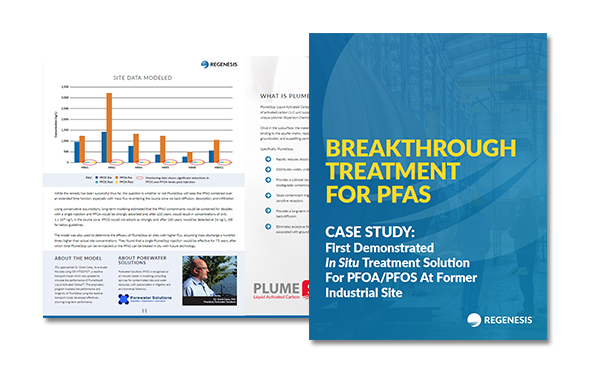Proven Experience on Complex Government and DoD Sites Ensures Safe and Effective Solutions
Resulting Contamination and Environmental Impacts
State, federal and DoD sites can be challenging and involve multiple parties overseeing the management and remediation of a site. Multiple stakeholders as well as environmental firms engaged in oversight, engineering, and application of a treatment solution is common.
Support
Working effectively across government agencies and a host of firms requires a solid understanding of the requirements and processes involved while dedicating the appropriate resources to support the team and reach treatment goals and regulatory guidelines.
Site Types
Soil and groundwater contamination at State, Federal and DoD sites can be the result of many related activities such as: military industrial process operations, fuel dispensing, transport and storage, vehicle/aircraft maintenance and cleaning, munitions use, landfilling, tactical use of herbicides and pesticides etc.
The most prevalent sources of contamination at these sites are related to underground storage tanks (USTs), spill areas, landfills and surface disposal areas. But new, emerging contaminants like PFAS compounds are now becoming more of a concern.

Contaminants
Primary categories of contaminants most often found at these sites include: volatile organic compounds, (VOCs), semivolatile organic compounds, (SVOCs), metals, fuels, explosives, and other inorganic compounds such as asbestos, arsenic, corrosives, pesticides, and herbicides. Typically encountered contaminants include: petroleum products, chlorinated solvents, heavy metals, polychlorinated biphenyls
Department of Defense Environmental Solutions

Approaches
Soil and groundwater remediation solutions may include the following: extensive source area treatment, free product removal, large dissolved-phase plume strategies, mixed plume treatment, down-gradient barriers, soil mixing, handling and treatment, excavations, biopiles, trenches, metals immobilization (specific to hex-chrome).

Solutions
These solutions can be achieved using well-documented, proven and cost-effective in situ approaches such as in situ chemical oxidation, enhanced anaerobic biodegradation, enhanced aerobic biodegradation and metals reduction.
Products Used in Department of Defense Remediation
REGENESIS provides a range of technologies for use at DoD sites which include: PlumeStop, 3-D MicroEmulsion, Bio-Dechlor INOCULUM, ORC Advanced (powder/pellets), RegenOx for underground infrastructure compatibility and PersulfOx, CRS, MRC, AquaZVI and MicroZVI.
Do you have a state, federal, or DoD remediation project?
Contact us to explore solutions and options.
FAQs about Department of Defense Sites
Sites formerly occupied by the DoD often have soil and groundwater impacts related to military activities such as fuel dispensing, transport and storage, vehicle/aircraft maintenance, munitions use, landfilling, and the tactical use of herbicides and pesticides. Contaminants commonly found on DoD sites include volatile organic compounds (VOCs), metals, fuels, explosives, and inorganic compounds such as asbestos, arsenic, pesticides, and herbicides. These compounds pose a risk to both human health and the surrounding environment.
As with the discovery of any environmental impact, the first step should be to immediately address any risk to human health or sensitive ecological site receptors. Once any immediate threats are mitigated, a longer-term remedial plan can be developed in compliance with federal, state, and local requirements. These plans should be developed in partnership with the U.S. Environmental Protection Agency, as well as state and local regulatory bodies. Communication with the local community should also be considered, with the encouragement of public comment as necessary.
While most environmental contamination can pose health hazards due to toxicity, the types of contaminant found on DoD sites can pose additional risks. For example, military munitions and explosives of concern (MEC) are unexploded ordnance (UXO) and other hazardous munitions materials left behind after live-fire training or testing, open burning and detonation, and burial could cause physical harm if dealt with irresponsibly. Besides the obvious danger of explosions, there can also be deleterious effects from exposure to chemical warfare agents or other hazardous substances in the munitions.

 Americas
Americas Europe
Europe Français
Français Deutsch
Deutsch Italiano
Italiano Español
Español















